Near the end of my summer at the UVic Climate Lab, all the scientists seemed to go on vacation at the same time and us summer students were left to our own devices. I was instructed to teach Jeremy, Andrew Weaver’s other summer student, how to use the UVic climate model – he had been working with weather station data for most of the summer, but was interested in Earth system modelling too.
Jeremy caught on quickly to the basics of configuration and I/O, and after only a day or two, we wanted to do something more exciting than the standard test simulations. Remembering an old post I wrote, I dug up this paper (open access) by Damon Matthews and Ken Caldeira, which modelled geoengineering by reducing incoming solar radiation uniformly across the globe. We decided to replicate their method on the newest version of the UVic ESCM, using the four RCP scenarios in place of the old A2 scenario. We only took CO2 forcing into account, though: other greenhouse gases would have been easy enough to add in, but sulphate aerosols are spatially heterogeneous and would complicate the algorithm substantially.
Since we were interested in the carbon cycle response to geoengineering, we wanted to prescribe CO2 emissions, rather than concentrations. However, the RCP scenarios prescribe concentrations, so we had to run the model with each concentration trajectory and find the equivalent emissions timeseries. Since the UVic model includes a reasonably complete carbon cycle, it can “diagnose” emissions by calculating the change in atmospheric carbon, subtracting contributions from land and ocean CO2 fluxes, and assigning the residual to anthropogenic sources.
After a few failed attempts to represent geoengineering without editing the model code (e.g., altering the volcanic forcing input file), we realized it was unavoidable. Model development is always a bit of a headache, but it makes you feel like a superhero when everything falls into place. The job was fairly small – just a few lines that culminated in equation 1 from the original paper – but it still took several hours to puzzle through the necessary variable names and header files! Essentially, every timestep the model calculates the forcing from CO2 and reduces incoming solar radiation to offset that, taking changing planetary albedo into account. When we were confident that the code was working correctly, we ran all four RCPs from 2006-2300 with geoengineering turned on. The results were interesting (see below for further discussion) but we had one burning question: what would happen if geoengineering were suddenly turned off?
By this time, having completed several thousand years of model simulations, we realized that we were getting a bit carried away. But nobody else had models in the queue – again, they were all on vacation – so our simulations were running three times faster than normal. Using restart files (written every 100 years) as our starting point, we turned off geoengineering instantaneously for RCPs 6.0 and 8.5, after 100 years as well as 200 years.
Results
Similarly to previous experiments, our representation of geoengineering still led to sizable regional climate changes. Although average global temperatures fell down to preindustrial levels, the poles remained warmer than preindustrial while the tropics were cooler:
Also, nearly everywhere on the globe became drier than in preindustrial times. Subtropical areas were particularly hard-hit. I suspect that some of the drying over the Amazon and the Congo is due to deforestation since preindustrial times, though:
Jeremy also made some plots of key one-dimensional variables for RCP8.5, showing the results of no geoengineering (i.e. the regular RCP – yellow), geoengineering for the entire simulation (red), and geoengineering turned off in 2106 (green) or 2206 (blue):
It only took about 20 years for average global temperature to fall back to preindustrial levels. Changes in solar radiation definitely work quickly. Unfortunately, changes in the other direction work quickly too: shutting off geoengineering overnight led to rates of warming up to 5 C / decade, as the climate system finally reacted to all the extra CO2. To put that in perspective, we’re currently warming around 0.2 C / decade, which far surpasses historical climate changes like the Ice Ages.
Sea level rise (due to thermal expansion only – the ice sheet component of the model isn’t yet fully implemented) is directly related to temperature, but changes extremely slowly. When geoengineering is turned off, the reversals in sea level trajectory look more like linear offsets from the regular RCP.
Sea ice area, in contrast, reacts quite quickly to changes in temperature. Note that this data gives annual averages, rather than annual minimums, so we can’t tell when the Arctic Ocean first becomes ice-free. Also, note that sea ice area is declining ever so slightly even with geoengineering – this is because the poles are still warming a little bit, while the tropics cool.
Things get really interesting when you look at the carbon cycle. Geoengineering actually reduced atmospheric CO2 concentrations compared to the regular RCP. This was expected, due to the dual nature of carbon cycle feedbacks. Geoengineering allows natural carbon sinks to enjoy all the benefits of high CO2 without the associated drawbacks of high temperatures, and these sinks become stronger as a result. From looking at the different sinks, we found that the sequestration was due almost entirely to the land, rather than the ocean:
In this graph, positive values mean that the land is a net carbon sink (absorbing CO2), while negative values mean it is a net carbon source (releasing CO2). Note the large negative spikes when geoengineering is turned off: the land, adjusting to the sudden warming, spits out much of the carbon that it had previously absorbed.
Within the land component, we found that the strengthening carbon sink was due almost entirely to soil carbon, rather than vegetation:
This graph shows total carbon content, rather than fluxes – think of it as the integral of the previous graph, but discounting vegetation carbon.
Finally, the lower atmospheric CO2 led to lower dissolved CO2 in the ocean, and alleviated ocean acidification very slightly. Again, this benefit quickly went away when geoengineering was turned off.
Conclusions
Is geoengineering worth it? I don’t know. I can certainly imagine scenarios in which it’s the lesser of two evils, and find it plausible (even probable) that we will reach such a scenario within my lifetime. But it’s not something to undertake lightly. As I’ve said before, desperate governments are likely to use geoengineering whether or not it’s safe, so we should do as much research as possible ahead of time to find the safest form of implementation.
The modelling of geoengineering is in its infancy, and I have a few ideas for improvement. In particular, I think it would be interesting to use a complex atmospheric chemistry component to allow for spatial variation in the forcing reduction through sulphate aerosols: increase the aerosol optical depth over one source country, for example, and let it disperse over time. I’d also like to try modelling different kinds of geoengineering – sulphate aerosols as well as mirrors in space and iron fertilization of the ocean.
Jeremy and I didn’t research anything that others haven’t, so this project isn’t original enough for publication, but it was a fun way to stretch our brains. It was also a good topic for a post, and hopefully others will learn something from our experiments.
Above all, leave over-eager summer students alone at your own risk. They just might get into something like this.

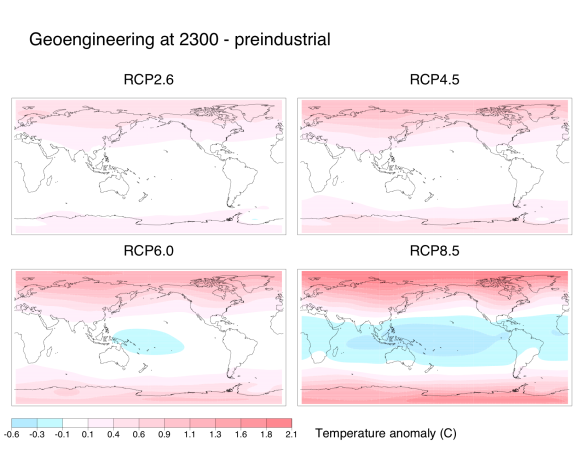
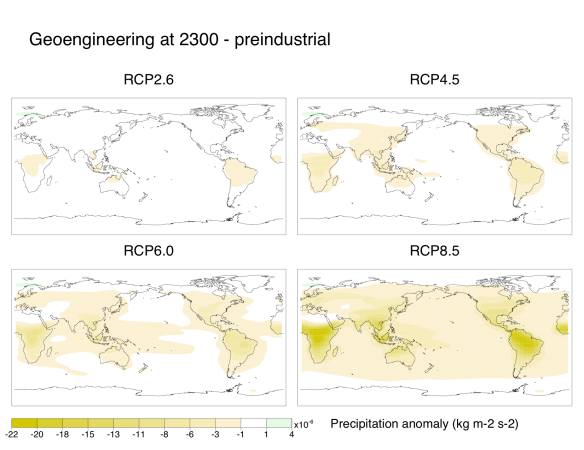
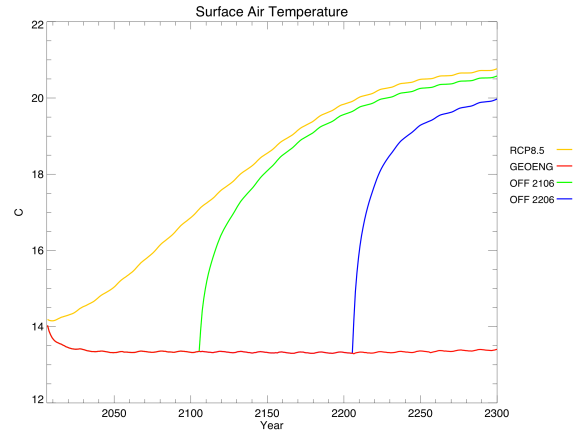


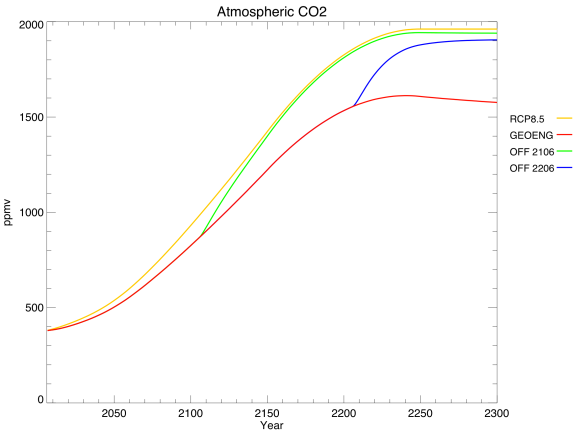

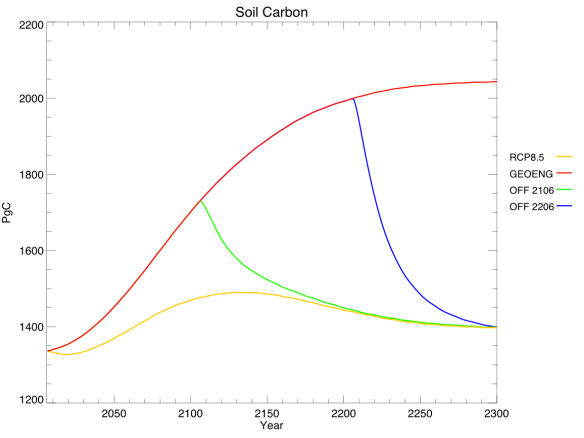
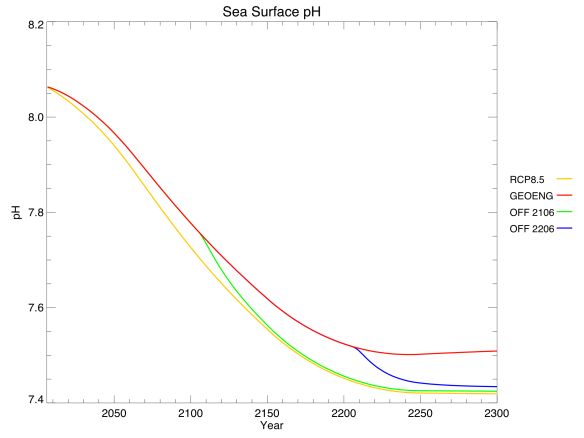
Great work — thanks!
Is you carry this further, it might be interesting to look at geoengineer concentrated at the poles. As we learn more about Arctic amplification and permafrost carbon and other carbon feedbacks, it seems like the poles are the key area we may not be able to allow to warm past a certain point. So it would make sense to me, if we had to geoengineer, to start there. That might have added benefits in terms of counteracting the effects of a falling equator-polar temperature differential, including the slowing of the jet stream.
Thanks Kate, Lots of computational modeling science to digest here – thank you for pushing the plausibility forward.
Dr Peter Ward – in a lecture on Paleoclimatology, repeated a joke that illustrates some of the causes of global warming:
Question: What’s the difference between flood basalt, a volcano and a Volvo?
Answer: Nothing. (since they all make CO2)
http://www.uwtv.org/video/player.aspx?pid=Z7U0dPLCodsx
Perhaps we can model what happens if we remove the Volvo.
Is this a deterministic model?
Yes, as are most climate models today.
A good piece of warning to anyone overly SRM-enthusiastic. Could you point me to a peer-reviewed article that presents this scenario of large and quick land carbon emissions after shutting down a SRM scheme? I think this should be at the core of SRM discussions in addition to the ‘moral hazard’ discussion!
The Matthews and Caldeira paper I cited in the post found the same effect.
Would a nuclear war between Iran and Israel have the aerosol effects as well as ensuing oil price increases to solve the problem?
I’m interested, perhaps morbidly so, in what happens if a country unilaterally starts a geoengineering project for their benefit, but it happens to negatively impact another country. What happens if both those countries are large powers? Or one is a large power but there are numerous negatively affected other countries? Or a small set of countries embarks on a project to fix their climate, which turns out to create poor food growing climatic conditions in Russia or the U.S.?
What does rcp stand for and where is a good location to learn about the different emission scenarios and their designations?
RCP stands for Representative Concentration Pathway. They are a set of four CO2 concentration curves, corresponding to emissions scenarios that range from negative to extremely high. You can read more here.
To what extent does increased CO2 lead to reduced water requirements for plants in the temperate zones, and is the effect of CO2 on evapotranspiration part of the model?
http://thinkprogress.org/climate/2012/09/19/865471/in-the-crazy-world-of-carbon-finance-coal-now-qualifies-for-emission-reduction-credits/
That’s one way to keep the carbon markets running. China and India are laughing all the way.
Is geoengineering worth it?
My tuppence says no, simply because the profit incentive will encourage businesses in the field of geoengineering to welcome (and perhaps even actively encourage the creation of) situations that require their solutions.
I cite as example the rejection as ‘unsustainable’ (sic) potential solutions to our current problems that would entail ‘damage to the economy’ — as in, for instance, redesigning public transport such that it wouldn’t entail individuals driving heavy metal boxes.
Fascinating stuff Kate – and very good to see published on a public forum.
If and when you get the chance for further exploration of the potentials, how about running a set with both carbon recovery and albedo restoration programs ? Given the risk of the latter being terminated unexpectedly, in practice the inclusion of the former would be a moral imperative as well as a strategic insurance – so modelling them together would seem rational.
The potential scale of carbon recovery via productive afforestation has been much understated thus far – felling trees is distinctly unpopular in some quarters – but the resources and yields are pretty clear. A study by WRI & WFN identified 1.6GHa.s globally as available for afforestation with native species without impacting farmland. This could, after two or three decades of establishment as coppice forestry, yield around 13GTs dry wood per year for village scale processing to charcoal, using basic 35% efficient retorts, thus yielding around 4.5GTs charcoal/yr. Beside the sale of primed charcoal as a soil fertility enhancer and soil moisture regulator, about 28% of the wood’s potential energy is released in the form of a crude wood-gas, which is readily converted to methanol or other liquid fuels, thus assisting the economics of this option. While significant additional feedstock is available from farm wastes etc, it is far more dispersed in origin and so harder to assemble in economic quantities. Mobile retorts might perhaps help resolve this issue, but the yield would still be minor compared to that from coppice forestry.
With regard to albedo restoration (which title in my view offers a far easier public acceptance than the technical ‘solar radiation management’) might I put in a word for cloud brightening as a focus of modelling ? Its clear advantages of local or regional targetting (e.g. over the arctic or NE Atlantic in summer), of using harmless seawater (rather than sulphates) which then rains out within about 9 days (rather than 2 years) would seem to make it a far more promising option for both official and public acceptance, and thus well worth modelling.
As an evaluation of the combined effects of the most promising options for geo-engineering, I’d venture to suggest that if you were to undertake such research it would plainly be original enough to warrant publication, though I trust that you’d also be able get it to the public via your excellent site.
Regards,
Lewis